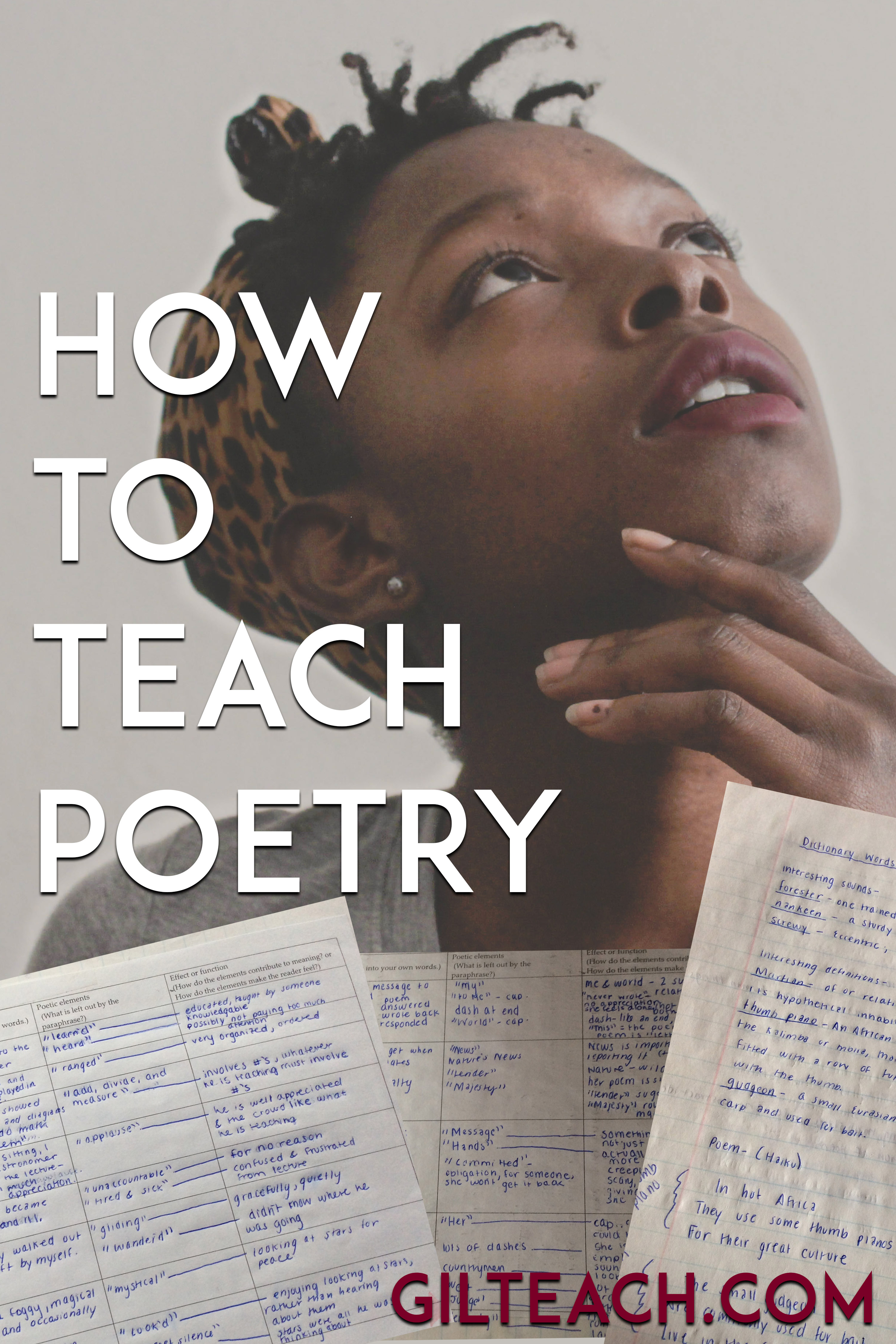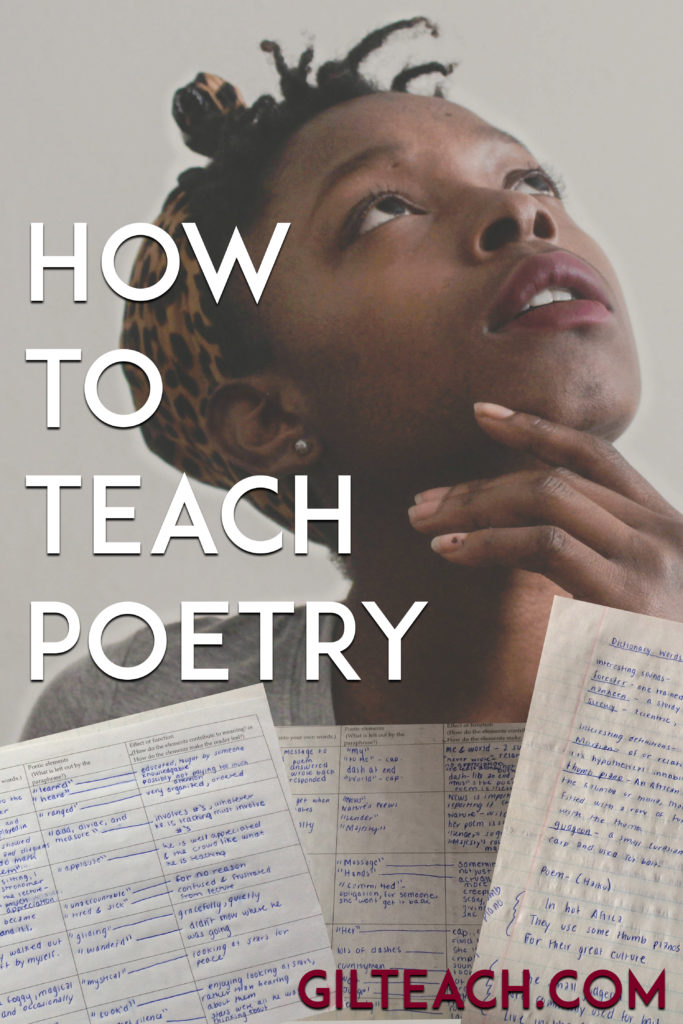How To Teach Poetry

How To Teach Poetry
April is National Poetry Month, and while I could happily spend hours analyzing a poem with a group of seventeen-year-olds, I know that not everyone feels that way.
Poetry is not always an easy sell. Students might not have much experience with poetry, or they don’t like it, or they think that it’s going to be too hard. But by the end of my introductory unit, I have won (almost) all of them over. They look back on the poetry unit as one of their favorite units of the year, and I refer back to the skills that they develop all year long.
It tool me a while to figure out my favorite method for analyzing poetry. I taught students to use TPCASTT for a long time (an acronym that stands for title, paraphrase, connotation, attitude, shifts, title, theme). There are some really helpful aspects to that process, but I’ve found that having students fill out a graphic organizer is the best way to move them beyond simple paraphrase towards a real discussion of how a poet’s choices create meaning in a poem.
Get your students reading, analyzing, and writing about poetry independently using these methods; check out my Poetry Lesson Plans: How To Teach Poetry For High School where you’ll find 24 pages of handouts and concrete, step-by-step lessons—which you can use tomorrow.

This is how I teach my students to read, analyze, understand, and enjoy poetry.
I do a quick review of the elements of poetry, going over explanations and examples to make sure that students understand what I mean when I say diction, syntax, metaphor, etc.. I don’t care so much about the minor differences between terms, but I do want to have some vocabulary in common.
Then, using a graphic organizer, we work through a poem together. So that students can see just how much there is to notice in any quality poem, we start off the unit with a full-class discussion on a single, short poem, and we usually spend two full class periods working through it together.
The first step to filling out the organizer is to paraphrase the poem in their own words. They’ll need to understand the basic meaning of the poem before they can do this, so often we look up words for their definitions. I explain this step in a few ways—sometimes, I tell students to “translate” the words, especially if they are reading an older or especially challenging poem. Sometimes, I’ll tell them to write the story of the poem, line by line—this works well for narrative poems. The idea is to make sure that they understand the basics of what is going on.
So they might change “This is my letter to the world” from the Emily Dickinson poem to “I have a message for everyone.” Or if they were to paraphrase “At every step you missed / my right ear scraped a buckle” from “My Papa’s Waltz” by Theodore Roethke, they might rewrite that as “your buckle scraped my ear whenever you missed a step.”
After that, we go back and make a list of everything that was left out of their paraphrase. The idea here is that whatever is not in their straightforward explanation is the “poetry” of the poem. This is the best way that I have found to really push students to notice those details. So they might realize the importance of diction in Dickinson’s poem when they notice that they left out the words “letter” and “world.” Or they might notice that in their paraphrase, the buckle scraped the ear and in the original, the speaker’s ear scraped the buckle—pointing out the strange syntax of the Roethke’s poem. Before we talk about what this all means, I get them to notice as many details as they can.
Then we talk about how the elements of poetry contribute to meaning. After a quick discussion of the main ideas of the poem, we look at how each of the elements that we noticed when we compared the paraphrase to the original contribute to the meaning of the poem. It’s also important at this point to shift and adjust our ideas about the themes as we discover and notice more details.
So at first, we might talk about how Emily Dickinson speaks of her poetry humbly, as a simple letter. But when we focus on the word “world,” we might discuss how in fact she views her writing as quite important. Or we might at first note how “My Papa’s Waltz” is a poem about abuse, but then, when we look at how the speaker in the poem blames himself for his father’s actions, as is noted in the strange syntax in which it’s his ear that does the scraping, the theme of the poem will shift to being something about how victims of abuse often blame themselves or try to cover up what is happening.
The ultimate goal is for students to be able to explain how the poet’s choices contribute to meaning. Then, after a week or so of practicing all of these steps with the same kind of organizer and different poems, students are ready to read, analyze, and write about poems without any assistance.
My other trick for teaching students to understand poetry is to get them to try their hand at writing some. We can analyze and discuss all day (and of course, I would happily keep doing that!) but until they try to convey their feelings about love through a metaphor or discover the joy of playing with a strange and bizarre word or think about how best to get a reader to understand their views on themes that are important to them, they’ll never fully understand how poetry works. As with the poetry analysis, I have some very specific steps that they can follow to write those poems.
Getting students to read and enjoy poetry is not always easy at first, but with the right tools, students will be empowered with the skills to find their own answers.
What questions do you have about teaching poetry?